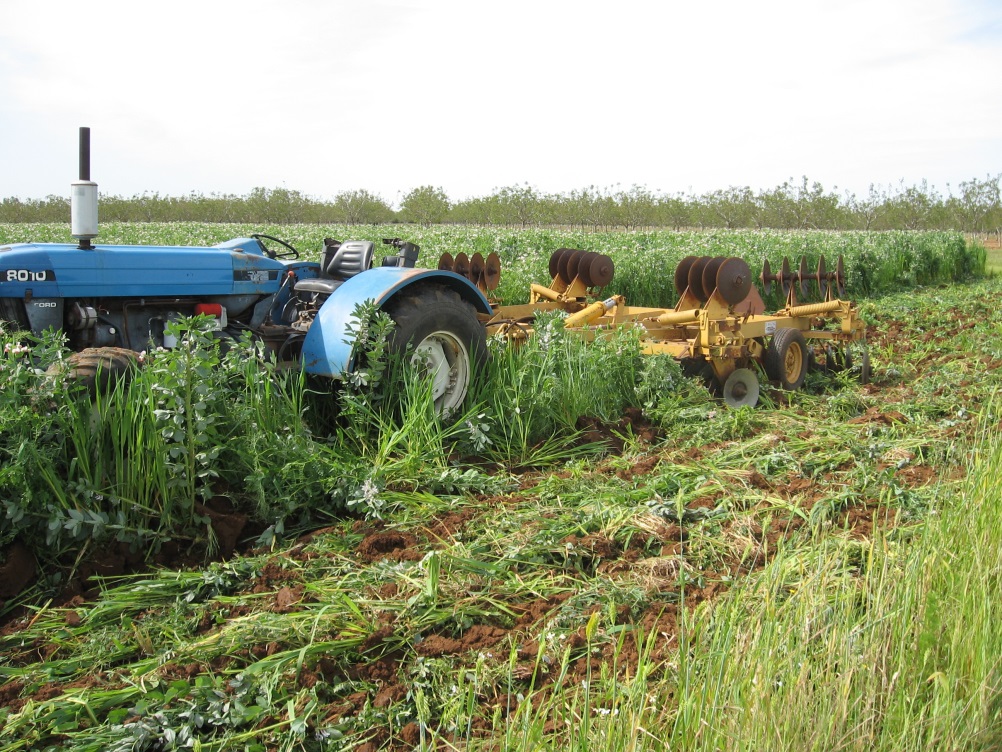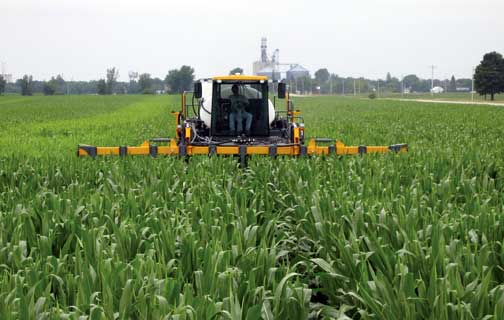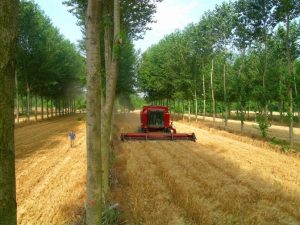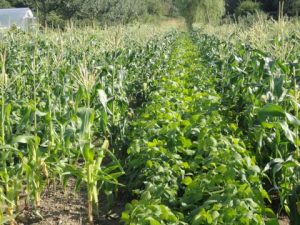Integrated Nutrient Management in the Subtropics
Nutrient management is a key component to increasing sustainable yields of crops in sub-tropic regions of the world. The heavily weathered soils and rapid degradation of existing organic matter in those soils makes for a seemingly insurmountable task of establishing viable agricultural crop systems.
An understanding of what factors are at work in your soils, and how to respond to them is an important first step. The important finding in research and actual practice in these regions; combined with known facts about the nature of these ecosystems and soils illustrate the importance of integrating (1) Biological (2) Organic and (3) Inorganic sources of nutrients in a balanced approach. Food security in the ever expanding populations of the tropics demands intensifying production on existing cropland; but long term sustainability means that any new land brought into production must be managed appropriately, and bringing abandoned land back into production where possible needs to be addressed.
Nutrient Management by Recycling:
One of the biggest inherent factors in the tropics is the lack of nutrient reserves in the soil. Even when utilizing leguminous crops that fix biological N from the atmosphere, there must be a focus on restoring nutrient reserves in the soil so as to encourage biological activity and long term cycling of nutrients back into the food system for future crops. This is accomplished by building organic matter while integrating nutrient management practices so as to have a readily available nutrient sink for economic crop yields.
It is a question of balance. In the tropics, less soluble elements, especially Phosphorus, need to be applied from external sources so as to increase the soluble phosphorus available for important plant growth processes…at the same time, the greatest loss of Phosphorus and other relatively insoluble building block elements is from soil erosion.
One of the best ways to accomplish bringing ‘life’ back to a soil, or helping the existing ‘life’ within a soil sustain itself is by utilizing organic sources of nutrients derived from composting of animal waste and high carbon mulching materials harvested from various sources. Compost, when managed properly using an aerobic approach (encourage oxygen) will not only supply macro and micro nutrients, but will carry with them valuable bacteria for converting crop residues and mulches to humus, and ultimately, to organic matter which can help provide that balanced nutrient pool.
Sufficiency Level of Added Nutrients (SLAN)
The basis of this method of soil analysis interpretation is to analyze elements that are presently available in the soil, and add only enough highly available nutrients (mostly in the form of fertilizers) to sustain the crop being grown. Taking this to application in the starved soils of the tropics is a good way to look at how to integrate your nutrient management and utilize highly soluble nutrient sources as only a portion of your total plan. For example: in highly leachable soils in regions where rainfall events are intense, applying the season’s worth of Nitrogen only to be washed away or leached brings little value in the end; and applying it in split applications of lower rates per ha at times in the season when it is needed the most will provide more yield at a lower cost.
Another example relates to Calcium, a key element to crop nutrition, cation exchange capacity, and overall nutrient balance. Where soils have depleted calcium reserves or highly acidic (pH) soils, Aluminum (Al) toxicity is prevalent. While in temperate zones such as Europe and the US, Calcium is applied at high rates in the form of limestone to correct this, and build Calcium reserves; the tropics may not be able to effectively accomplish this because of the lack of organic, chemical, and biological balance in the soils. The dominance of Al in these soils of low pH can be just as effectively balanced by lower rates of limestone per acre applied over time so as to reduce Al solubility, reducing its toxicity to crops for the crop cycle, retaining more Calcium in the nutrient ‘sink’, and creating a healthier soil because Al is also a deterrent to sustaining desirable microbial life (the cornerstone of converting organic sources to plant available forms).
Integration is the Key
The primary goal of integrated nutrient management (INM) is to combine old and new methods of into ecologically sound and economically viable systems. This management strategy focuses on using available sources of organic (crop residues, compost, cover crops, green and animal manures, etc) and inorganic (synthetic fertilizers and soil amendments) sources of nutrients in a judicious and efficient way. This will, in time, optimize all aspects of nutrient cycling. The goal is to tightly manage nutrient cycling in harmony with nutrient demand by the crop and nutrient release in the soil…all the while, keeping an eye on minimizing losses through leaching, runoff, volatilization and immobilization in a sensitive soil and unique climate.

Disking in a cover crop of peas and triticale. A good practice in Nutrient Management is using the living cover to take up and retain nutrients, and then incorporating it with a minimal amount of tillage helps slow the release to the next crop. Source: (Grass Valley Grains – Cover Crop/Cash Crop Rotations: Saving the Environment and Your Checkbook)
Optimization of Organic Matter
Rates of decomposition of both fresh plant residues and humidified soil organic matter are three to five times greater in the humid tropical environment than under temperate conditions (Jenkinson and Ayanaba 1977; Mueller-Harvey et al. 1985). This means that organic materials like mulches, manure, compost, and living covers must be added to the soil more frequently, and in greater amounts. Some strategies to accomplish this include:
- Utilize and manage as many organic forms available to you in your situation. Recycle plant and animal residues, green manures, and cover crops as a cornerstone to your crop production system.
- Minimize tillage and disturbance of the soil in the crop to be grown. By maintaining the residue and mulch, you will slow the decomposition down and create the necessary ‘stages’ of decomposition, the beneficial bacteria populations to keep balance within each, and build your nutrient ‘pool’ while protecting the soil from being washed away or depleted.
- Keep the surface soil temperatures cooler by mulching with plant residues so as to keep a mulch layer present. This ‘cooler’ soil environment will slow the breakdown and loss of nutrients, organic matter, and valuable microbes to the environment. It will also prevent the volatilization of Nitrogen as it converts to plant available forms; and slow its leaching as Nitrate when heavy rains come. Utilize crop residue from prior crops whenever practical.
- Rotate crops to include perennial field crops like clover, small grains, and appropriate crops that can provide plenty of cover. Utilize intercropping techniques, combining multipurpose trees, perennial crops, alley farming, and other approaches so as to be always encouraging the buildup of organic matter in the soil.
Judicious and Precise Use of Inorganic Sources of Nutrients
Finally, the use of added fertilizer, limestone, gypsum, and other purchased inputs are not only expensive, but overuse can actually disrupt the balance of your living soil. Understand your crop’s needs, learn how to estimate or measure what your soil will provide, learn how much contribution your organic matter can account for, and then apply the correct analysis and form of fertilizer as the last step, and use as little as you need to so as to accomplish the goal. When attempting to buffer the soil and preventing the negative effects from acidic pH, apply Calcium in small amounts, spread out over time, and ahead of the cropping season so as to buffer Aluminum and Iron which are toxic to many crops which need more neutral pH.
One of my key resources for this article was from the Food and Fertilizer Technology Center for the Asian and Pacific Region, an article entitled: Soil Nutrient Management for Sustained Food Crop Production in Upland Farming Systems in the Tropics by Hossner and Juo, Soil and Crop Sciences Department, College Station, Tennessee, USA. You can read the article and the research in its entirety by clicking the link.
Other suggested readings and resources used in this article include:
Introduction to Alley Farming, Food and Agriculture Organization, UN
Integrated Crop Management – Iowa State University
How do you liked this post? Let us know in Facebook or Google+





